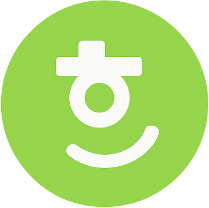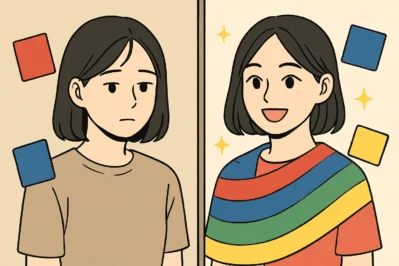What’s Your Personal Color? Master Korean Colors!
Hello! Welcome to [Maeil Hangul], here to upgrade your Korean skills!
Have you ever been shopping in Korea and wanted to ask for a different color? Or maybe you want to describe your favorite K-pop idol’s new hair color? Today, we’re going to learn the essential skill of describing colors in Korean!
And we’ll do it with a trendy twist! In Korea right now, “Personal Color Analysis” (퍼스널 컬러 진단) is a massive trend. Everyone, from celebrities to students, is getting diagnosed to find out which colors make them look best. By learning colors today, you’ll not only be able to describe things, but you’ll also understand a huge part of modern K-culture!
Let’s dive in and add some color to your Korean!
Core Expressions You Need to Know
Here are the key words and patterns for talking about colors.
1. The Basics: Red, Blue, Yellow
- Korean Expression: 빨간색 (ppalgan-saek), 파란색 (paran-saek), 노란색 (noran-saek)
- Pronunciation [Romanized]: [ppal-gan-saek], [pa-ran-saek], [no-ran-saek]
- English Meaning: Red color, Blue color, Yellow color
- Detailed Explanation: These are the foundational colors. The word 색 (saek) means “color.” So you’re literally saying “red color,” “blue color,” and so on. It’s super easy to remember! You can use these words to describe almost anything.
2. Asking “What Color?”
- Korean Expression: 무슨 색이에요?
- Pronunciation [Romanized]: [mu-seun saeg-i-e-yo?]
- English Meaning: What color is it?
- Detailed Explanation: This is your go-to question when you want to ask about the color of an item. 무슨 (museun) means “what” or “which,” and 색이에요 (saeg-ieyo) means “is it color?” It’s a polite and natural phrase you can use with store staff or friends.
3. Answering “It is [Color].”
- Korean Expression: [Color] + -이에요/예요. (e.g., 빨간색이에요)
- Pronunciation [Romanized]: [ppal-gan-saeg-i-e-yo]
- English Meaning: It is red.
- Detailed Explanation: This is the pattern to answer the question! Just take the color word (like 빨간색) and add 이에요 (ieyo). If a word ends in a vowel, you use 예요 (yeyo), but since all our color words end with the consonant ‘ㄱ’ (k) in 색 (saek), you will always use 이에요 (ieyo).
- It is blue -> 파란색이에요 (paran-saeg-ieyo).
- It is yellow -> 노란색이에요 (noran-saeg-ieyo).
Example Dialogue: Shopping for Makeup
Let’s see how these expressions are used in a real conversation, inspired by the “Personal Color” trend!
- A: 와! 이 틴트 정말 예뻐요. 무슨 색이에요?
- (Wow! This lip tint is so pretty. What color is it?)
- B: 이거요? 이건 빨간색이에요. 제 퍼스널 컬러가 ‘웜톤’이라서 잘 어울려요.
- (This one? It’s red. It suits me well because my “personal color” is ‘Warm Tone’.)
See? B is using her knowledge of personal colors to choose her makeup!
Culture Tip & K-Trend Deep Dive
Let’s Talk About “Personal Color” (퍼스널 컬러)!
You heard the term ‘웜톤’ (wom-ton) or “Warm Tone” in the dialogue. This is the heart of the personal color trend in Korea!
- What is it? It’s a service where a consultant analyzes your skin undertone, eye color, and hair color to determine your “season” (Spring Warm, Summer Cool, Autumn Warm, or Winter Cool).
- Why is it so popular? Koreans believe that wearing your “personal colors” makes your skin look clearer and more vibrant. People use this information to choose everything from clothes and makeup to hair dye and accessories. It’s a fun activity to do with friends, and many K-pop idols and actors have shared their personal color results, making the trend even bigger!
- How you can use it: Now that you know the basic colors, you can talk about your own preferences like a true Korean trendsetter! You can say: “저는 파란색을 좋아해요.” (jeo-neun paran-saeg-eul jo-a-hae-yo) – “I like blue.”
Let’s Review & Practice!
Great job today! You learned how to say basic colors like 빨간색 (red), 파란색 (blue), and 노란색 (yellow). You also learned how to ask 무슨 색이에요? and answer with [Color]이에요.
Now, time for a quick quiz!
Practice Question:
- Your friend is pointing at a banana. How would you say “It is yellow” in Korean?
___________________________________
(Answer: 노란색이에요)
You’re doing amazing! Keep practicing, and you’ll be describing the world in Korean in no time.
What’s YOUR favorite color? Leave a comment below using the [Color] + -이에요 pattern we learned today!






